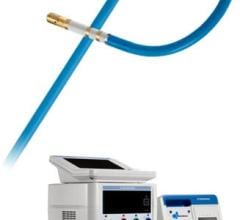May 14, 2019 — The Heart Rhythm Society (HRS) in partnership with three other professional societies issued an international consensus statement reflecting a worldwide updated review of the indications, techniques and outcomes of catheter ablation of ventricular arrhythmias (VAs). The expert consensus statement was presented at Heart Rhythm 2019, the HRS’s 40th Annual Scientific Sessions, May 8-11 in San Francisco.
VAs are abnormal rapid heart rhythms that originate in the lower chambers of the heart, known as the ventricles, and are sometimes associated with heart attacks or scarring of the heart muscle. VAs come in a variety of forms, from single premature ventricular complexes (PVCs) to sustained ventricular tachycardia and fibrillation, and are an important cause of morbidity and mortality. Today, catheter ablation has become a more common treatment option for patients whose condition cannot be controlled by medical therapy. In an effort to better understand, diagnose and treat VAs, the field of catheter ablation has progressed rapidly with the development of new methods and tools, and with the publication of clinical trial outcomes and key learnings.
The EHRA/HRS Expert Consensus on Catheter Ablation of Ventricular Arrhythmias, first issued in 2009, outlined recommendations and best practices for the catheter ablation procedure. The 2019 document — compiled by HRS,the European Heart Rhythm Association (EHRA), the Asia Pacific Heart Rhythm Society (APHRS), and the Latin American Heart Rhythm Society (LAHRS) — is a complete and comprehensive update of the 2009 EHRA/HRS statement and is intended to supplement the 2017 AHA/ACC/HRS Guideline for Management of Patients with Ventricular Arrhythmias and the Prevention of Sudden Cardiac Death.
"Over the last decade, the field of electrophysiology has undergone rapid progress and the number of ablations performed across the globe has grown significantly," said document chair Edmond Cronin, MB, BCh, BAO, FHRS, CCDS, CEPS-A, Hartford Hospital. "From new literature and clinical trials to technology innovations and improved understanding of ventricular arrhythmias, our organizations recognized the overdue need for an updated consensus statement to reflect the vast advancements."
The writing group, comprised of 38 experts from international organizations, addresses the important issue of catheter ablation of VAs. The consensus statement uses a systematic review designed specifically for the document as part of HRS’s efforts to adopt the rigorous methodology required for guideline development, and was led by an experienced evidenced-based practice committee. Where possible, the recommendations are evidence-based with the intention to set reasonable standards that can be applicable worldwide. The group also addresses the need for appropriate physician training and identified patient suitability for the procedure in the clinical setting.
Specifically, the document includes detailed findings within the following topic areas:
-
Definitions, Mechanisms and History of Ventricular Arrhythmia Ablation;
-
Clinical Evaluation;
-
Indications for Catheter Ablation;
-
Procedural Planning;
-
Intraprocedural Patient Care;
-
Electrophysiological Testing;
-
Mapping and Imaging Techniques;
-
Mapping and Ablation;
-
Postprocedural Care;
-
Training and Institutional Requirements and Competencies; and
-
Future Directions
"The purpose of this much-needed document is to serve as an updated resource guide and comprehensive review of the field for clinicians around the world who are working to improve the care of patients undergoing ablation for ventricular arrhythmias," said document vice-chair Frank Bogun, M.D., University of Michigan. "With knowledge gained from this review, we recognize that moving forward, further research is needed to identify optimal methods of arrhythmia suppression and to understand the influencers of each method on arrhythmia outcomes."
The expert consensus statement on catheter ablation of VAs was written in collaboration with and endorsed by the American College of Cardiology (ACC), the American Heart Association (AHA), the Japanese Heart Rhythm Society (JHRS), the Pediatric and Congenital Electrophysiology Society (PACES) and the Sociedade Brasileira de Arritmias Cardíacas (SOBRAC). It was also endorsed by the Canadian Heart Rhythm Society (CHRS).
The final decisions regarding patient care should be made by healthcare providers and their patients. The organizations also strongly encourage additional patient-centered, prospective and randomized trials to move the field forward to promote patient health and minimize confounding biases.
The full document was published in the online edition of HeartRhythm, the official journal of the Heart Rhythm Society; EP Europace, a journal of the European Society of Cardiology; and the Journal of Arrhythmia, the official journal of the Japanese Heart Rhythm Society and the Asia Pacific Heart Rhythm Society.
For more information: www.heartrhythmjournal.com


 March 27, 2025
March 27, 2025 








